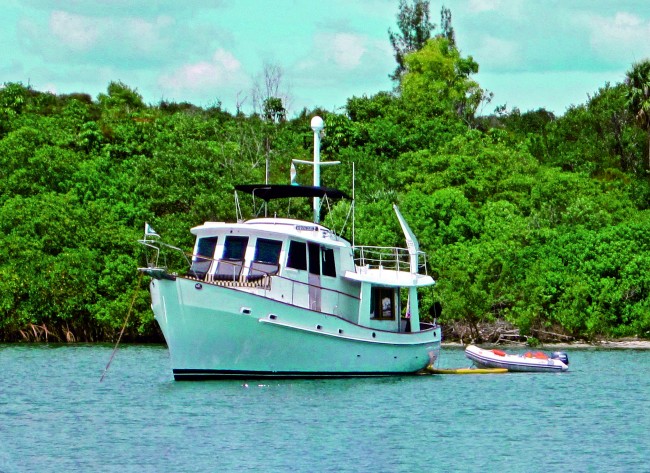Excerpt from "ANCHORING–A Ground Tackler's Apprentice"

- Scope: A ratio between the length of rode deployed and the vertical distance from the boat's deck to the buried anchor.
Scope is one of three essential components necessary to prevent dragging—anchor size and anchor design being the other two. Of these three, only scope can produce that critical low shank-to-bottom angle that allows the anchor to achieve its maximum holding power.
To calculate scope, add together: 1) the depth of water; 2) the height to the bow roller; and, 3) any additional height of tide. For anything but the mildest weather, also include: 4) the depth to which the anchor buries—a foot or two in sand, up to 12+ feet in mud; 5) the height of any storm surge—2+ feet for gales to 15+ feet for hurricanes; and, 6) the height of waves—2-3 feet in protected anchorages to 6+ in less protected anchorages, higher if the wind opposes the current.
Multiply this sum: for all rope rodes by 10, for rodes that are half rope and half chain by 7, or for all chain rodes by 5, resulting in scope ratios of 10:1, 7:1, or 5:1 respectively.
However, these long-used ratios for scope apply only in mild conditions when the catenary, that sag caused by the weight of the rode, allows: 1) the anchor's shank-to-bottom angle to be zero, and, 2) for a portion of the rode to lay on the seabed, creating some boat-holding friction.

But, once the wind starts to pick up, even if the rode is made of a 'heavier' chain or has a kellet installed, the catenary will start to get pulled out. This decreases the amount of rode resting on the seabed, resulting in less boat-holding friction, and, as the rode lifts off of the seabed, an increase in the anchor's shank-to-bottom angle which diminishes the anchor's holding power. It is noteworthy that studies have shown that once the rode lifts off the bottom, an anchor with a scope of 5:1 has only half the holding power as it would have with a scope of 10:1. This should not come as a surprise since this is the same principle used to weigh anchor—shorten the rode, which increases the anchor's shank-to-bottom angle, and the easier it is for the anchor to come out of the bottom.
So, once the wind exceeds the point at which the rode starts to lift off the bottom, say 15 knots, dispose of those long used guidelines of 5:1 and 7:1, and deploy more rode. Go for and maintain a shank-to-bottom angle of 6 degrees or less—a scope of at least 10:1, and if you've skimped on or may have omitted any of the six components for calculating scope, let out even more rode.
However, calculating scope is only one half of the equation, the other half is knowing, accurately, the amount of rode deployed. To meet this requirement the rode must be marked—every 25 feet works well, and once the 100 foot mark is reached, the sequence of marks can start over. There are also meters that can be attached to some windlasses that measure the amount of rode let out.
Alas, there is yet another important factor—adequate scope must also be accompanied with adequate swing room; be certain to have plenty of both.
Rudy and Jill Sechez have been cruising and living onboard since 1997, first on a 37' wood sailboat, which they built in their backyard, then on Briney Bug, a 34' sail-assisted wood trawler, which they designed and built. They are authors of "ANCHORING–A Ground Tackler's Apprentice", and are speakers on the topics of anchoring, cruising simply and frugally, and tips for navigating the ICW.













